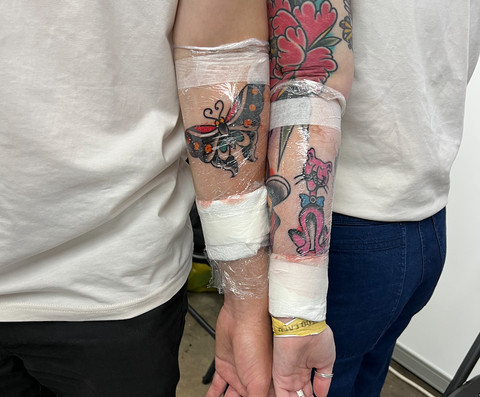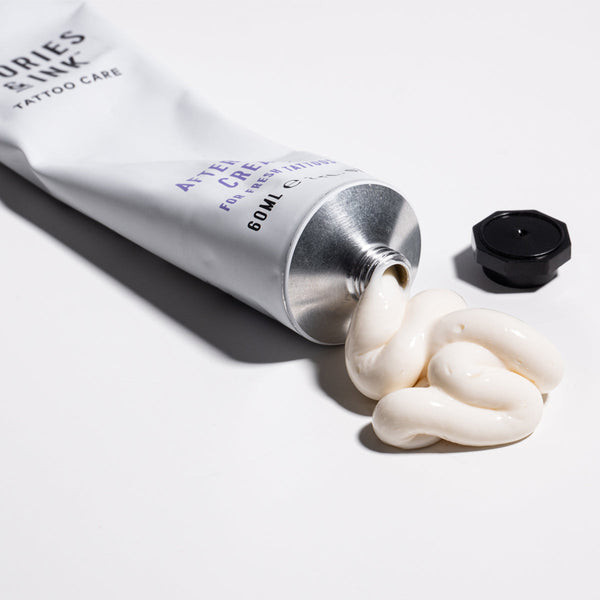When Do Tattoos Heal? The healing time for a new tattoo typically ranges from two to four weeks, but this can vary depending on individual factors and the type of tattoo. At tattooat.com, we’re dedicated to providing you with all the information you need for a smooth and successful tattoo healing process. Understanding the healing stages and proper aftercare is crucial for ensuring your tattoo looks its best and remains vibrant for years to come. Learn about the tattoo healing stages, aftercare tips, and signs of infection to ensure proper tattoo aftercare and long-lasting ink vibrancy.
1. How Does Tattooing Actually Work?
The magic of tattoos lies in a precise and intricate process. When you get a tattoo, the ink is deposited into the dermis layer of your skin, which is located beneath the epidermis (the outer layer). According to Liv Dodds, a tattoo artist from Northumberland, UK, your body recognizes this ink as a foreign substance and initiates an immune response. White blood cells, specifically macrophages, are sent to the area to engulf the ink particles. However, these macrophages are unable to fully break down the ink, and they remain in the dermis, effectively trapping the pigment and making the tattoo permanent. This meticulous process, involving both artistry and biological reactions, ensures that your tattoo becomes a lasting part of you.
2. What Happens in the First 24 Hours After Getting a Tattoo?
The first 24 hours are critical for setting the stage for proper healing. Redness, swelling, and slight irritation are normal, as your skin reacts to the tattooing process. Your tattoo artist will cover the new tattoo with a bandage, such as plastic wrap or a specialized breathable tattoo film (second skin), to protect it from bacteria and external irritants. Always follow your artist’s specific instructions on how long to keep the initial bandage on.
Liv Dodds emphasizes the importance of keeping the tattoo clean and preventing infection: “The most important part of the first 24 hours is keeping your tattoo clean and fresh. This means no touching it (not even your friends/family when you show it off), and keeping it wrapped to eliminate as much bacteria as possible.” Washing the tattoo gently with a mild, fragrance-free cleanser can also help soothe the area.
 Tattoo artist applying a bandage to a new tattoo
Tattoo artist applying a bandage to a new tattoo
3. What Are Pro Tips for Tattoo Healing?
Following these “do’s” and “don’ts” from tattoo professionals is essential for a smooth tattoo recovery:
Do:
- Wear loose clothing to avoid rubbing and irritation.
- Keep the tattoo clean and moisturized with tattoo-friendly products.
- Allow the tattoo to breathe by avoiding excessive bandaging.
Don’t:
- Submerge the tattoo in water (baths, pools, etc.) during the healing period. Showers are fine.
- Let pets or animals lick or rub against the tattoo.
- Engage in heavy exercise for at least 48 hours.
- Pick at scabs or peeling skin.
- Expose the tattoo to direct sunlight.
4. How Long Does It Generally Take for a Tattoo to Heal Completely?
Generally, a tattoo takes about 2 to 4 weeks to heal on the surface, but the skin underneath can take up to 6 months to fully repair. According to Dr. Nicolas Kluger, a professor of Dermatology at Helsinki University Hospital, if a tattoo hasn’t healed within a month, there might be an underlying issue such as an allergy or infection. Factors such as the type of tattoo (light designs heal faster than those with large areas of color) and its location on the body can affect healing time. Proper aftercare, including keeping the area clean and moisturized, is vital. If you experience persistent redness, pain, or discharge, seek medical advice promptly.
5. Can Medication Affect Tattoo Healing?
Certain medications can indeed affect how quickly your tattoo heals. Dr. Nicolas Kluger advises caution for individuals on isotretinoin (acne treatment) or high doses of corticosteroids (anti-inflammatory drugs), as these can delay the healing process. However, he notes that individuals with well-controlled diabetes should not experience significant concerns during tattooing. Always inform your tattoo artist about any medications you are taking to ensure they can provide appropriate advice.
6. What Are the Different Stages of Tattoo Healing?
Understanding the stages of tattoo healing helps you recognize what’s normal and when to seek help:
- Week 1: Redness, inflammation, oozing, and a burning sensation are common. Avoid re-wrapping the tattoo to prevent moisture buildup.
- Week 2: Itchiness, flaking, and scabbing occur. Resist the urge to pick or scratch, as this can lead to scarring.
- Weeks 3-4: The tattoo may appear dull as a layer of dry skin forms. This will naturally exfoliate, revealing the vibrant tattoo beneath.
- 1-6 Months: The skin continues to repair itself. Continue your aftercare routine, even if the tattoo looks fully healed.
7. What Are the Signs That a Tattoo May Be Infected?
While complications are rare, it’s important to recognize the signs of a possible infection:
- Persistent Redness: Redness that doesn’t subside after a few days.
- Skin Feels Hot: Radiating heat from the tattoo area.
- Oozing Fluid: Pus or excessive fluid discharge beyond the first few days.
- Fever or Chills: Systemic signs of infection.
- Worsening Pain: Increasing pain instead of gradual improvement.
- Swollen, Puffy Skin: Significant swelling around the tattoo.
- Severe Itching or Hives: Suggesting an allergic reaction.
If you experience any of these symptoms, seek medical attention immediately.
8. Can I Use Sunscreen on My Healing Tattoo?
No, it’s best to avoid applying sunscreen to a healing tattoo. Sunscreens contain chemicals that can irritate the open wound. Instead, protect your new tattoo from the sun by wearing loose clothing until it is fully healed. After it’s healed, regular sunscreen use is essential to prevent fading and maintain the tattoo’s vibrancy.
9. What Should I Put on My Healing Tattoo?
Your tattoo artist will recommend specific aftercare products, but generally, a gentle, fragrance-free moisturizer is ideal. Products like Stories & Ink Aftercare Cream are designed to soothe, calm, and repair damaged skin after tattooing. Regular moisturizing keeps the skin hydrated, promoting faster and more comfortable healing.
 Stories & Ink tattoo Aftercare Cream
Stories & Ink tattoo Aftercare Cream
10. What Other Factors Affect Tattoo Healing?
Several other factors can influence tattoo healing time:
- Age: Younger individuals tend to heal faster than older adults.
- Overall Health: A strong immune system promotes faster healing.
- Lifestyle: Factors like smoking and excessive alcohol consumption can hinder healing.
- Tattoo Size and Complexity: Larger, more intricate tattoos take longer to heal.
- Tattoo Location: Areas with more movement or friction may heal slower.
11. Why Is It Important to Avoid Picking at a Healing Tattoo?
Picking at scabs on a healing tattoo is a big no-no because it can lead to several complications that affect both the appearance and health of your skin. When you pick at a scab, you’re essentially removing the protective layer that your body has created to heal the wound. This can pull out ink, leading to patchy or faded areas in your tattoo, which nobody wants. More seriously, picking can introduce bacteria, increasing the risk of infection, which can cause significant damage and require medical treatment. Additionally, picking can damage the underlying skin, potentially causing scarring that distorts the tattoo’s design. It’s always best to let the tattoo heal naturally, keeping it clean and moisturized to support the healing process without interference.
12. What Role Does Diet Play in Tattoo Healing?
Your diet can actually play a supportive role in the healing process. Eating a balanced diet rich in vitamins, minerals, and proteins provides your body with the necessary building blocks to repair damaged skin. Vitamin C, found in citrus fruits and leafy greens, is crucial for collagen production, which helps in skin regeneration. Zinc, present in nuts, seeds, and whole grains, aids in wound healing and boosts the immune system. Protein, available in lean meats, fish, and legumes, is essential for tissue repair. Staying hydrated is also key, as water helps maintain skin elasticity and supports overall cellular function. While a healthy diet won’t magically speed up healing, it will ensure your body has the resources it needs to recover efficiently.
13. How Do Different Tattoo Styles Affect Healing Time?
The style of your tattoo can influence how quickly it heals. Tattoos with fine lines and minimal shading, like minimalist designs, generally heal faster because they involve less trauma to the skin. Conversely, tattoos with extensive color packing, heavy shading, or large areas of solid ink require more passes over the same area, leading to more significant skin disruption and a longer healing time. Techniques like dot work or watercolor, which are less invasive, might also heal more quickly than traditional styles. The complexity of the design and the amount of ink deposited play a crucial role in determining the duration of the healing process.
14. Can Stress Levels Affect Tattoo Healing?
Yes, stress levels can indeed impact how well your tattoo heals. When you’re stressed, your body releases cortisol, a hormone that can suppress the immune system and slow down the healing process. High cortisol levels can reduce the body’s ability to fight off infection and repair tissue, which is essential for tattoo recovery. Additionally, stress can lead to unhealthy habits like poor diet, lack of sleep, and neglecting aftercare routines, all of which can hinder healing. Managing stress through relaxation techniques, regular exercise, and a balanced lifestyle can support your immune system and promote faster, more effective tattoo healing.
15. How Important Is It to Keep a Healing Tattoo Moisturized?
Keeping a healing tattoo moisturized is incredibly important because it helps to prevent the skin from drying out, which can lead to cracking, scabbing, and itching. When the skin is properly moisturized, it remains supple and elastic, facilitating the skin’s natural repair processes. A good quality, fragrance-free moisturizer creates a protective barrier that keeps bacteria out while locking in moisture, supporting faster and more comfortable healing. Regularly applying a thin layer of moisturizer also reduces the risk of scarring and helps to maintain the vibrancy of the tattoo ink, ensuring your tattoo looks its best once fully healed.
16. What Happens If My Tattoo Gets Sunburned During Healing?
If your tattoo gets sunburned during the healing process, it can cause significant damage and complications. Sunburn on a fresh tattoo can lead to inflammation, blistering, and severe pain. The intense heat from the sun can also cause the ink to fade or become distorted. Moreover, sunburn damages the skin’s cells, prolonging the healing time and increasing the risk of infection and scarring. It’s crucial to keep a healing tattoo protected from the sun by wearing loose, protective clothing or staying in the shade. If a sunburn does occur, treat it gently with cool compresses and a fragrance-free, aloe-based lotion to soothe the skin, and consult a healthcare professional if symptoms are severe.
17. How Do I Choose the Right Aftercare Products for My Tattoo?
Choosing the right aftercare products is essential for ensuring your tattoo heals properly and looks its best. Look for products that are specifically designed for tattoo aftercare, as they are formulated to be gentle on the skin and promote healing. Opt for fragrance-free, alcohol-free, and hypoallergenic products to minimize the risk of irritation or allergic reactions. Ingredients like shea butter, coconut oil, and vitamin E can help moisturize and soothe the skin. Avoid products containing petroleum, lanolin, or heavy perfumes, as these can clog pores and interfere with the healing process. Always follow your tattoo artist’s recommendations, as they can provide personalized advice based on your skin type and the specific tattoo.
18. What Are Some Common Mistakes People Make During Tattoo Healing?
People often make several common mistakes during the tattoo healing process that can hinder recovery and affect the tattoo’s appearance. One of the biggest mistakes is not following the artist’s aftercare instructions closely, which can lead to infections or poor healing. Over-moisturizing or using the wrong type of lotion can also cause problems by trapping bacteria or irritating the skin. Another frequent mistake is exposing the tattoo to direct sunlight, which can cause fading and damage. Picking at scabs is a big no-no as it can remove ink and lead to scarring. Additionally, neglecting to keep the tattoo clean or submerging it in water can increase the risk of infection. Being diligent and informed about aftercare is key to avoiding these pitfalls and ensuring a successful healing process.
19. How Do I Know If I’m Allergic to Tattoo Ink?
Knowing if you’re allergic to tattoo ink can be tricky, but there are several signs to watch for. Allergic reactions typically manifest as persistent itching, redness, swelling, or the development of small bumps or hives around the tattoo. These symptoms can appear days, weeks, or even years after getting the tattoo. Certain ink colors, particularly red, are more commonly associated with allergic reactions due to the presence of specific pigments. If you suspect an allergy, it’s important to consult a dermatologist or allergist for proper diagnosis and treatment. They may perform patch testing to identify the specific allergen and recommend appropriate management strategies, such as topical or oral antihistamines or corticosteroids.
20. How Can I Prevent My Tattoo from Fading Over Time?
Preventing your tattoo from fading over time involves consistent care and protection. The most important step is to shield your tattoo from the sun, as UV rays are a major cause of fading. Apply a high SPF, broad-spectrum sunscreen to your tattoo whenever it’s exposed to sunlight, even on cloudy days. Keeping your skin moisturized is also crucial, as hydrated skin helps maintain the vibrancy of the ink. Avoid harsh chemicals and abrasive cleansers that can strip the skin of its natural oils. Additionally, maintaining a healthy lifestyle, including staying hydrated, eating a balanced diet, and avoiding smoking, can contribute to the longevity of your tattoo’s appearance.
21. Is It Normal for a Tattoo to Peel During the Healing Process?
Yes, it is absolutely normal for a tattoo to peel during the healing process. Peeling is a natural part of how your skin repairs itself after the trauma of tattooing. As the damaged outer layers of skin die off, they are shed to reveal the new, healed skin underneath. This process typically starts around the end of the first week and can last for one to two weeks. It’s important to let the peeling happen naturally and resist the urge to pick at the flakes, as this can remove ink and cause scarring. Keeping the area moisturized can help to alleviate any discomfort and support the healing process.
22. Can I Exercise After Getting a Tattoo?
Exercising after getting a tattoo requires some precautions to ensure proper healing. It’s generally recommended to avoid strenuous activities for at least the first 48 hours. Excessive sweating can create a breeding ground for bacteria, increasing the risk of infection. Additionally, friction from clothing and equipment can irritate the new tattoo. When you do resume exercising, wear loose, breathable clothing to minimize rubbing. After your workout, gently clean the tattoo with a mild, fragrance-free cleanser and reapply a thin layer of moisturizer. Listen to your body and avoid any exercises that cause excessive stretching or pulling of the skin in the tattooed area.
23. How Does the Tattoo Artist’s Skill Impact Healing Time?
The skill and experience of the tattoo artist can significantly impact healing time. A skilled artist will use proper techniques to minimize trauma to the skin, such as using the correct needle depth and avoiding excessive passes over the same area. This reduces inflammation and promotes faster healing. They will also provide clear and detailed aftercare instructions tailored to your skin type and the specific tattoo. A clean and sterile environment in the tattoo studio is also crucial to prevent infections, which can greatly prolong the healing process. Choosing a reputable and experienced artist is an investment in the health and longevity of your tattoo.
24. Is It Possible to Be Allergic to a Specific Color of Tattoo Ink?
Yes, it is possible to be allergic to a specific color of tattoo ink. Certain pigments used in tattoo inks are more likely to cause allergic reactions than others. Red ink, in particular, is a common culprit due to the presence of mercury sulfide or other sensitizing compounds. Other colors like yellow, blue, and green can also trigger allergies, although less frequently. Allergic reactions can manifest as itching, redness, swelling, or the formation of small bumps around the tattoo. If you suspect an allergy to a specific ink color, consult a dermatologist or allergist for testing and treatment. They may recommend avoiding that color in future tattoos or suggest alternative ink formulations.
25. How Do I Maintain the Vibrancy of My Tattoo Over Time?
Maintaining the vibrancy of your tattoo over time requires consistent care and protection. Sun protection is paramount, so always apply a high SPF, broad-spectrum sunscreen to your tattoo whenever it’s exposed to sunlight. Keep your skin well-hydrated by drinking plenty of water and using a good quality moisturizer regularly. Avoid harsh chemicals and abrasive cleansers that can strip the skin of its natural oils. Additionally, consider incorporating antioxidants into your diet or skincare routine, as they can help protect the skin from damage caused by free radicals. Periodic touch-ups by a skilled tattoo artist can also help refresh the colors and lines of your tattoo, keeping it looking its best for years to come.
Ready to embark on your tattoo journey? Explore endless design inspiration, connect with talented artists, and discover expert tips on tattoo care at tattooat.com. Let us help you find the perfect piece of art and ensure it heals beautifully. Visit tattooat.com today!
Address: 1825 SW Broadway, Portland, OR 97201, United States
Phone: +1 (503) 725-3000
Website: tattooat.com
